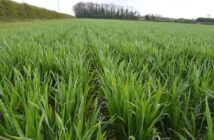Growers should plan to use a robust T2 application based on the best SDHI chemistry this season, despite apparently low disease levels and ongoing dry weather.
That’s the advice from BASF agronomy manager Jared Bonner, who believes there is still plenty of time for most crops to reach their full potential.
“There are some dry-looking crops in my area of East Anglia and in many other areas across the country, but they could still deliver some excellent yields if they get rain in the next couple of weeks.
“However, that rain is also very likely to encourage an explosion of disease, so crops will need maximum protection during the all-important grain filling stage.”
Although disease is not obvious on upper leaves at the moment, there is plenty lower down in crops, says Mr Bonner. “People might think disease pressure is low, but yellow rust is evident in several varieties already this season. The new races are cycling faster and at colder temperatures, so be vigilant.”
There has also been plenty of dew so Septoria will have travelled up the plant, he adds. “It’s a myth that you need lots of rains splash to spread the spores.
“Septoria might may be latent for now, but without proper protection it will reappear, particularly if it turns wet. A well-timed spray using Xemium chemistry at T2 will pay dividends.”
The key aim of the T2 timing is to protect the newly emerged flag leaf and top up protection for leaves two and three. Given that these three leaves generate around 80% of final yield, that means keeping disease out for at least four weeks after the flag leaf is fully emerged, he advises.
“It is tempting to cut back in a season like this, but having been dry for so long can we be really confident it is going to stay that way? You are protecting against what is to come, not what has happened before.”
Despite reports of early flag leaf emergence in some areas, most crops are on target for a T2 application in the third/fourth week of May across southern England and a week or so later further north, says Mr Bonner.
“The ideal T2 timing is when the flag leaf is fully emerged. This should be the case even if that means shortening the T1-T2 interval, or where a T1.5 has been applied,” he advises.
“It should also be the case if the T1-T2 interval is a bit stretched, or where less robust chemistry was used at T1. In these cases a higher dose of Xemium at T2 will demonstrate the best of its curative activity.”
Growers looking to trim costs should think about rate before product. Whatever the weather pattern, the T2 spray timing delivers the best margin and independent trials have proven that crops treated with a sequence of Xemium-based fungicides Adexar and Librax deliver the highest yields, says Mr Bonner.
“In 70 comparisons by ADAS, SRUC and NIAB TAG in 2014 and 2015, Adexar- and Librax-treated crops have delivered an average yield benefit over Aviator of 0.2 t/ha, £20/ha.
“And results from 2016 show that an Adexar/Librax programme consistently delivered over £30/ha additional margin.”
The recommended rate is 1.25 litres/ha plus 1 litre/ha of chlorothalonil at T2, for both Adexar and Librax. “It is important that the interval from T1 is not stretched beyond three to four weeks,” Mr Bonner advises.
Real Results Circle
The efficacy of Xemium is being tested further this season through the BASF Real Results Circle initiative.
Fifty selected farmers across the UK are comparing their choice of fungicide at T1 and T2 against the standard BASF Adexar/Librax-based sequence.
The trials are supported by independent partners ADAS and AgSpace and will produce statistically valid results comparing margin over fungicide costs across a range of varieties, geographic areas and disease pressures.
For further information and to keep up to date on trials progress go to www.basfrealresults.co.uk




